#devotion to railway
Text
In March 1939 the LMS sends Stranraer a Class 5 to test. It goes very well and soon Stranraer is awash in secondhand Black Fives. The funny part is "a hard core of ex-Caley men" at Northern Division headquarters have feels! They are OFFENDED that the Stranraer men prefer the new engines to "their incomparable 60 class" and so they insist they repeat the test with a Caley 4-6-0!
The test appears to go sadly and Stranraer's like "Hmm yes, thank you for that interesting experience (we'll be sticking with the Staniers)" and headquarters insist, insist, "[a]s a great favour," that they keep the test engine.
#thanks guys#the caley management's devotion to their stupid engines is actually rather touching in a hilarious way#real true railway stuff#... but... wait for it...#caledonian engines#scottish engines#glasgow and south western engines#david l. smith
24 notes
·
View notes
Audio
Clips from Friends at the Table - Sangfielle
Song Used: Marie (National Treasure Soundtrack) - Cristobal Tapia De Veer
Other Sangfielle Character Edits:
Duvall | Marn | Chine
Transcript Below:
--(21)--
Austin (as Interrogator): What’s the worst thing you've ever done to another person?
Jack (as Pickman): [soft, thoughtful breath]
Austin (as Interrogator): Please respond to the question. Delays will be noted.
Jack (as Pickman): Once I fed a short man and his wife to the furnace at the heart of a Shape train, but this was what they had asked me to do.
--(28)--
Jack (as Pickman): William Blick, I curse you with the power of the Shape. If you make a move against us, Black Hook will come down on you from the north and consume you. Do you understand?
Austin: ... His eyes go look at you, and then they look down at the wound you've left on his hand, and on the Shape mark, little droplets of blood are riding the Shape.
Jack: Ooh!
Austin: Moving up and down it in beads.
Ali: Yowza.
Jack: Oh, it's working. [Ali laughs]
Austin: It's working. And so he—
Jack: Glancing at Marn. [chuckles]
Austin: And he looks back up at you and goes:
Austin (as Blick): [grumbles]
Austin: And spits on the ground, and says:
Austin (as Blick): Yeah, yeah, yeah. Shape Knights.
--(28)--
Jack: And I'm going to...I'm gonna try and speak with the Shape or commune with the Shape in some way.
...
Jack: And I think, yeah, I think she just closes her eyes and says…
Jack (as Pickman): I have not asked much of you, and I do not plan to in future. But I am prepared to offer you a great prize. This place and those that command it seek to take everything from you and remake you in their image. If you let me, I will do what I can to open a door to this place through which you may run. Tell me what I can do.
--(28)--
Austin: The Shape Knights have found your heresy. A hunter has been dispatched.
--(13)--
Jack (as Pickman): What you are doing here is very dangerous and you’re going to get people killed, not least of all yourself. What have you done to this train.
...
Austin (as Chantilly): The Shape takes many forms, Knight. You ought learn some new ones.
--(40)--
Austin (as Alekest): Yeah, well, my understanding is that you are traveling with a very unorthodox Shape Knight,
--(56)--
Jack: I think anybody who isn't Pickman or anybody who isn't a Shape Knight ... might just be killed by this.
--(20)--
Jack (as Pickman writing a letter): “I am sorry, but there is no going back. You have become a creature of fire and majesty.”
...
Jack: “I am sorry for where you are, and I hope that you become violent and magnificent.”
#my audio edits#sangfielle#friends at the table#might do another one called pickman babygirl mix where its just pickman being mean/pragmatic/quiet#but this one's about devotion to an eldritch railway babeyyy. she fucked that shackled engine
159 notes
·
View notes
Text
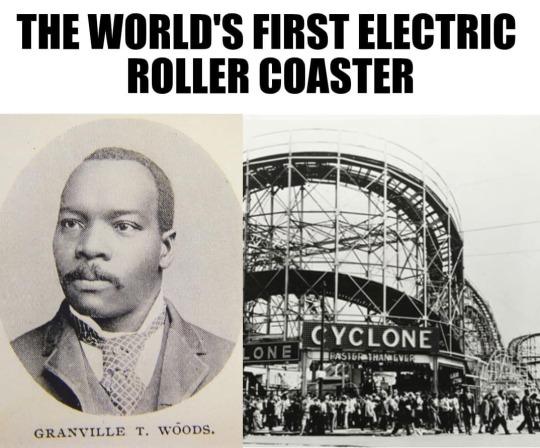
THE WORLD'S FIRST ELECTRIC ROLLER COASTER
Granville T. Woods (April 23, 1856 – January 30, 1910) introduced the “Figure Eight,” the world's first electric roller coaster, in 1892 at Coney Island Amusement Park in New York. Woods patented the invention in 1893, and in 1901, he sold it to General Electric.
Woods was an American inventor who held more than 50 patents in the United States. He was the first African American mechanical and electrical engineer after the Civil War. Self-taught, he concentrated most of his work on trains and streetcars.
In 1884, Woods received his first patent, for a steam boiler furnace, and in 1885, Woods patented an apparatus that was a combination of a telephone and a telegraph. The device, which he called "telegraphony", would allow a telegraph station to send voice and telegraph messages through Morse code over a single wire. He sold the rights to this device to the American Bell Telephone Company.
In 1887, he patented the Synchronous Multiplex Railway Telegraph, which allowed communications between train stations from moving trains by creating a magnetic field around a coiled wire under the train. Woods caught smallpox prior to patenting the technology, and Lucius Phelps patented it in 1884. In 1887, Woods used notes, sketches, and a working model of the invention to secure the patent. The invention was so successful that Woods began the Woods Electric Company in Cincinnati, Ohio, to market and sell his patents. However, the company quickly became devoted to invention creation until it was dissolved in 1893.
Woods often had difficulties in enjoying his success as other inventors made claims to his devices. Thomas Edison later filed a claim to the ownership of this patent, stating that he had first created a similar telegraph and that he was entitled to the patent for the device. Woods was twice successful in defending himself, proving that there were no other devices upon which he could have depended or relied upon to make his device. After Thomas Edison's second defeat, he decided to offer Granville Woods a position with the Edison Company, but Woods declined.
In 1888, Woods manufactured a system of overhead electric conducting lines for railroads modeled after the system pioneered by Charles van Depoele, a famed inventor who had by then installed his electric railway system in thirteen United States cities.
Following the Great Blizzard of 1888, New York City Mayor Hugh J. Grant declared that all wires, many of which powered the above-ground rail system, had to be removed and buried, emphasizing the need for an underground system. Woods's patent built upon previous third rail systems, which were used for light rails, and increased the power for use on underground trains. His system relied on wire brushes to make connections with metallic terminal heads without exposing wires by installing electrical contactor rails. Once the train car had passed over, the wires were no longer live, reducing the risk of injury. It was successfully tested in February 1892 in Coney Island on the Figure Eight Roller Coaster.
In 1896, Woods created a system for controlling electrical lights in theaters, known as the "safety dimmer", which was economical, safe, and efficient, saving 40% of electricity use.
Woods is also sometimes credited with the invention of the air brake for trains in 1904; however, George Westinghouse patented the air brake almost 40 years prior, making Woods's contribution an improvement to the invention.
Woods died of a cerebral hemorrhage at Harlem Hospital in New York City on January 30, 1910, having sold a number of his devices to such companies as Westinghouse, General Electric, and American Engineering. Until 1975, his resting place was an unmarked grave, but historian M.A. Harris helped raise funds, persuading several of the corporations that used Woods's inventions to donate money to purchase a headstone. It was erected at St. Michael's Cemetery in Elmhurst, Queens.
LEGACY
▪Baltimore City Community College established the Granville T. Woods scholarship in memory of the inventor.
▪In 2004, the New York City Transit Authority organized an exhibition on Woods that utilized bus and train depots and an issue of four million MetroCards commemorating the inventor's achievements in pioneering the third rail.
▪In 2006, Woods was inducted into the National Inventors Hall of Fame.
▪In April 2008, the corner of Stillwell and Mermaid Avenues in Coney Island was named Granville T. Woods Way.
473 notes
·
View notes
Text
ANALYSING Q!SLIME'S FINAL BIRTHDAY GIFT [12/08/2023]
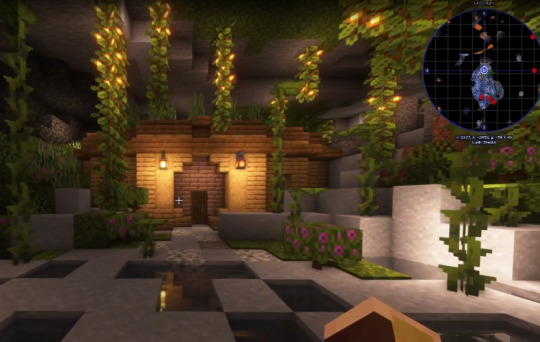
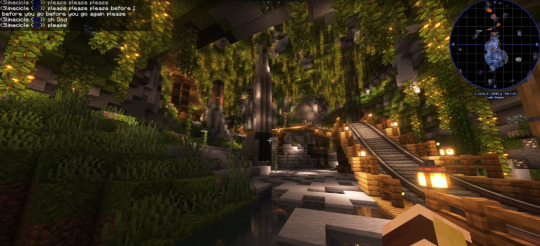
With the addition of the underground railway within the mines of q!Slime's Eggxile base, the choices on the birthday build (from the lead-up, the threshold, to the house itself) adds so much on to q!Slime's character as well as gives hints on the bigger picture of the Federation and the new wave of codes.
Prior to today's Birthday stream, the two significant builds in Eggxile are the Altar to Lil J and the Basement - two builds that represent q!Slime's religious devotion and his familial devotion respectively.
I did an analysis comparing the two in another post HERE as a Part 1 - big recommend to read through that one before this one when you can!
This time I'll be going into detail specifically about the underground railway and how it represents q!Slime's 'devotion' to the island itself and the Federation.
long rambling ahead be careful
[EXPLANATION UNDERCUT]
PREVIOUS KNOWLEDGE:
Quick SparkNotes summary about Slime's way of building:
Slime's builds are simplistic, symmetrical layouts (preferably circular)
Comprised of mostly local, easy to obtain/manufacture materials
A lot of flora interior
NO security, little-to-no input from the Create-mod
These characteristics were derived from the similarities between Slime's existing builds of the Altar and the Basement. The uncanniness of the Birthday Build is that it is an extension NOT built by Slime, but instead is the Federation's attempt to imitate his style and forcibly insert itself into his life.
We can presume that this is the Federation's doing and by extension JuanaFlippa's current identity by the context clues during the scavenger hunt. The main giveaway being the location of the START placed at the QSMP Dinner Hall: the first sightings of the Egg Codes and the location of Gegg's assassination. The detail of the FIRST CLUE as well being Slime's train ticket to the island supports this theory in assumption that it was the Federation that both brought the original 17 residence to the island and is currently withholding the tickets themselves.
The scavenger hunt goes as planned, all in all directing Slime back to his Eggxile base. (Note the poster being placed IN FRONT of the school's only exit)

THRESHOLD BETWEEN THIS WORLD AND THE NEXT:
Not much of Slime's actual base is touched in the scavenger hunt other than the nook in the Basement Slime had originally designed to be JuanaFlippa's area. Here it is decorated with the carpet, two chairs, and two presents. Everything before that (lamps including) was made by Slime.

After Slime collects what he believes is the last of the presents the lamps in the Basement are progressively removed directing him to the only other light in room being the black wool platform and chest. These lamps were destroyed NOT turned off. The contents of the chest read as follows:


Hostile architecture is defined as a design strategy to purposefully guide or restrict movement (targeting mostly the homeless. it sucks). And by limiting Slime's vision here is the first of many examples of the Federation restricting Slime's movement as the path progressively becomes more and more forced.
From here to the mine entrance Slime is still given a physical choice whether or not to follow the light. This is the Federation's way in giving Slime the illusion of free choice. 'You chose to follow the light' 'You chose to break that wall in the mines' 'You chose to activate the train carriage'



The train carriage and its small, difficult to move around, interior being the last direct choice Slime makes. It locks him inside and sends him on a trip that goes no where but down, deeper into the mines.
It's worth noting that originally these mines originally belong to Slime. He made this entrance and he was able to freely explore any part of these caves. What the train carriage does is give Slime a strict path to follow and a very limited window to look through - no straying from the path here. Look only where the Federation tells you to.
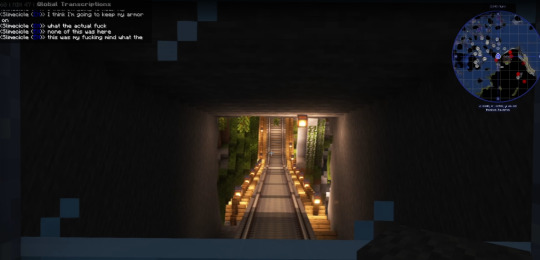

Given the connection between codes and trains, symbolically this can also represent Slime's gradual spiral (the shape of the tracks) into hell - the madness that is the island led on by the Federation.
JUANAFLIPPA'S HOUSE:
The road ends at a small house at the very bottom of the lush caves. It's a nice house! Supposedly trying to replicate the arched partition walls in the Basement... But not quite perfectly imitating his style of build. The giveaways being its asymmetry and the choice of materials: a variety of different wood types, most NOT local to Eggxile (also the fake house just looks prettier wwww)

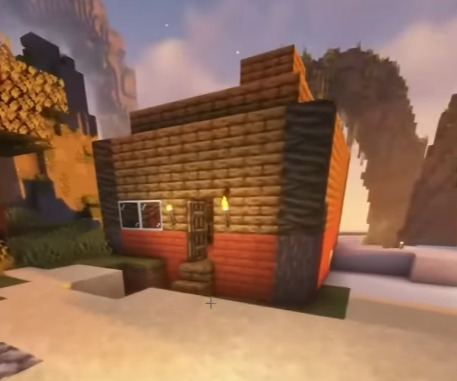
Here's the two houses for comparison (Slime's house is an 8x8 block square)
Stylistically, the vibe of this house given the location and purpose remind me of that one Cold War bunker in Las Vegas. An underground mansion designed to look like the outside world - a secluded, controlled paradise for a family to live in.

The confirmation that the underground house being a facade becomes clearer the deeper Slime explores the inside.

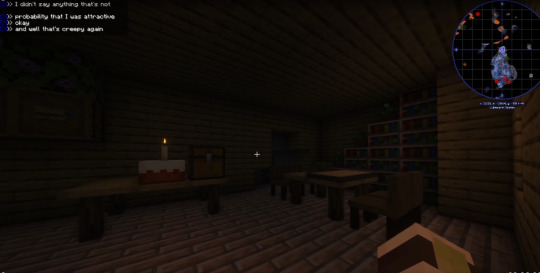
Normal interior. Normal kitchen. Normal table: 4 chairs (like the outside bonfire), 3 mugs (Slime, Mariana, Juanaflippa). Shelves like Slime's old house in Sacapuntas. A passageway in the wall leading to Juanaflippa's room.
All these things portraying the life Slimeriana and Juanaflippa could have lived. A happy family tucked under from all the dangers of the outside, far far away from the world. Until you look deeper into the cracks only to find out it was all fake, there is nothing back there. A mockery in disguise of a gift.

THE FEDERATION AND SLIME:
Prior to the birthday stream with the assassination of Gegg, Slime had initially come to terms that Juanaflippa was well and truly dead and had told ElQuackity (a member of the Federation) that he no longer had any attachments to the island, and because of that would try to be himself.
The Federation responded to this twice: the first being ElQuackity offering a position to work with them and ElQuackity win the Elections (this fails as ElQuackity is assassinated by q!BBH); the second being this birthday stream.
So far the Federation has not destroyed anything Slime has built but instead added on top of it. These decisions both give Slime a reason to stay on the island whilst pushing him to do things aligned with the Federation's goals shown by the gifts he gets in the scavenger hunt (Ghillie suit, landmines, grappling hook, dark metal ingots).


Interestingly the 2nd prize during the scavenger hunt is quite literally called the CHARLIE Flag and is the nautical symbol for YES. While the purpose of this flag is for whatever mission the Federation is about to send Slime on, this is also metaphorical as the only response Slime can give right now is YES.
Additionally the flag metaphor could be applied on the controls at the beginning of the tracks: Red flag both socially and in Nautical terms (BRAVO) meaning danger/carrying dangerous cargo.
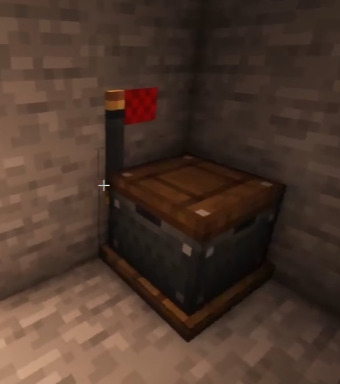
These are literal red flags in the world in the architecture that are warnings to Slime that once he 'agrees' to these terms and conditions, life for him will only get more dangerous with no way in turning back. Deliberate decisions made by the Federation in guise of Slime's actions and the places he's impacted in the world.
In the end, Slime is a product of the early QSMP and how its history shapes a person and is represented physically by the builds he makes. By the interference of the new tech and prettier structures, the Federation overwrites Slime's creations against his will, creating a world unfamiliar to him - blending what is the truth of the past with the new, augmented present. In another context, change like this can be a good thing - but in this circumstance presents itself as an invasive decision into Slime's private life. This is the Federation forcibly applying itself as one of Slime's priorities in sacrifice of rewriting everything Slime has gone through.
#stufff rambles#long post#slimecicle#qsmp#qsmpblr#qsmp analysis#qsmp spoilers#wish I could add more research on more cultural/historic symbolism tho this what comes to mind at the moment#Something else I wanted to add (idk where itd go) being Slime's healing arc sharing similarities w/ the Orpheus and Eurydice story#He keeps going to the end holding onto hope until the very end where he turns around to lose everything and damning everyone#this story visually being when Slime tries to run after Juanaflippa suddenly losing sight of her
375 notes
·
View notes
Text

THE WORLD'S FIRST ELECTRIC ROLLER COASTER
Granville T. Woods (April 23, 1856 – January 30, 1910) introduced the “Figure Eight,” the world's first electric roller coaster, in 1892 at Coney Island Amusement Park in New York. Woods patented the invention in 1893, and in 1901, he sold it to General Electric.
Woods was an American inventor who held more than 50 patents in the United States. He was the first African American mechanical and electrical engineer after the Civil War. Self-taught, he concentrated most of his work on trains and streetcars.
In 1884, Woods received his first patent, for a steam boiler furnace, and in 1885, Woods patented an apparatus that was a combination of a telephone and a telegraph. The device, which he called "telegraphony", would allow a telegraph station to send voice and telegraph messages through Morse code over a single wire. He sold the rights to this device to the American Bell Telephone Company.
In 1887, he patented the Synchronous Multiplex Railway Telegraph, which allowed communications between train stations from moving trains by creating a magnetic field around a coiled wire under the train. Woods caught smallpox prior to patenting the technology, and Lucius Phelps patented it in 1884. In 1887, Woods used notes, sketches, and a working model of the invention to secure the patent. The invention was so successful that Woods began the Woods Electric Company in Cincinnati, Ohio, to market and sell his patents. However, the company quickly became devoted to invention creation until it was dissolved in 1893.
Woods often had difficulties in enjoying his success as other inventors made claims to his devices. Thomas Edison later filed a claim to the ownership of this patent, stating that he had first created a similar telegraph and that he was entitled to the patent for the device. Woods was twice successful in defending himself, proving that there were no other devices upon which he could have depended or relied upon to make his device. After Thomas Edison's second defeat, he decided to offer Granville Woods a position with the Edison Company, but Woods declined.
In 1888, Woods manufactured a system of overhead electric conducting lines for railroads modeled after the system pioneered by Charles van Depoele, a famed inventor who had by then installed his electric railway system in thirteen United States cities.
Following the Great Blizzard of 1888, New York City Mayor Hugh J. Grant declared that all wires, many of which powered the above-ground rail system, had to be removed and buried, emphasizing the need for an underground system. Woods's patent built upon previous third rail systems, which were used for light rails, and increased the power for use on underground trains. His system relied on wire brushes to make connections with metallic terminal heads without exposing wires by installing electrical contactor rails. Once the train car had passed over, the wires were no longer live, reducing the risk of injury. It was successfully tested in February 1892 in Coney Island on the Figure Eight Roller Coaster.
In 1896, Woods created a system for controlling electrical lights in theaters, known as the "safety dimmer", which was economical, safe, and efficient, saving 40% of electricity use.
Woods is also sometimes credited with the invention of the air brake for trains in 1904; however, George Westinghouse patented the air brake almost 40 years prior, making Woods's contribution an improvement to the invention.
Woods died of a cerebral hemorrhage at Harlem Hospital in New York City on January 30, 1910, having sold a number of his devices to such companies as Westinghouse, General Electric, and American Engineering. Until 1975, his resting place was an unmarked grave, but historian M.A. Harris helped raise funds, persuading several of the corporations that used Woods's inventions to donate money to purchase a headstone. It was erected at St. Michael's Cemetery in Elmhurst, Queens.
LEGACY
▪Baltimore City Community College established the Granville T. Woods scholarship in memory of the inventor.
▪In 2004, the New York City Transit Authority organized an exhibition on Woods that utilized bus and train depots and an issue of four million MetroCards commemorating the inventor's achievements in pioneering the third rail.
▪In 2006, Woods was inducted into the National Inventors Hall of Fame.
▪In April 2008, the corner of Stillwell and Mermaid Avenues in Coney Island was named Granville T. Woods Way.
#granville t woods#black inventor#invented#world's first#electric roller coaster#1893#read about him#read about his invention#reading is fundamental#knowledge is power#black history
123 notes
·
View notes
Text
youtube
The long awaited apology now up on youtube and a new buisness plan in place for the future. This is it! This is what we have been begging them to do for DAYS! It should feel like a win but even with this pivot, I think the watcher boys have still irreparably damaged their brand image.
Watcher waited too long to adress this and now theyve lost the trust of their fans. Everyone and their mother are reevaluating if these guys we've loved for years are actually some sorta secret monsters and the parasocial relationship is crumbling underfoot. 3 days ago everyone thought Steven Lim was the devil personified twirling his moustache while tying Shane and Ryan to the railway tracks like some poor damsels in a silent movie. 2 days ago people started loosing faith in Ryan, saying him and steven must have bullied Shane into it. But while some people always held steadfast that the watcher boys are equally at fault in this, Shane was always getting the benefit of the doubt. That is until yesterday when Saras mr beast comment on tumblr caused even the most devoted Shane apologists to questioning if mr. Eat the rich was never on our side to begin with.
Most of us are admitting that watcher just doesnt hit the same way that unsolved did. We've stuck around because we wanted to stand by the guys, yet I dont know how this will continue to play out with this collective idea of who these people were being shattered for all to see. Look at the body language in the update, the guys are terrified, Shane spends most of it looking like a kicked puppy on the brink of tears. They know that they've fucked up. I can only hope they learn something from this and listen to what people have told them because watcher is more fragile now than its ever been before.
#watcher#watcher entertainment#ghost files#steven lim#ryan bergara#shane madej#ghoul boys#watcher tv#Youtube
26 notes
·
View notes
Text
Self-realisation and life duties
For those wondering how to reconcile a life of work, studies or obligations with self-realisation, you don't have to stop those activities (Robert said the same thing, you give it up mentally). I compiled a bunch of Q&As with Ramana Maharshi on the topic which may be helpful guidance.
Q: Is solitude necessary for a Jnani?
M: Solitude is in the mind of man. One might be in the thick of the world and maintain serenity of mind; such a one is in solitude. Another may stay in a forest, but still be unable to control his mind. He cannot be said to be in solitude. Solitude is a function of the mind. A man attached to desire cannot get solitude wherever he may be; a detached man is always in solitude.
Q: So then, one might be engaged in work and be free from desire and keep up solitude. Is it so?
M: Yes. Work performed with attachment is a shackle, whereas work performed with detachment does not affect the doer. He is, even while working, in solitude.
Q: Is work an obstruction to Self-realisation?
M: No. For a realised being, the Self alone is the Reality and actions are only phenomenal; not affecting the Self. Even when he acts he has no sense of being an agent. His actions are only involuntary and he remains a witness to them without any attachment. There is no aim for this action. Even one who is still practising the path of Wisdom (jnana) can practise while engaged in work. It may be difficult in the earlier stages for a beginner, but after some practice it will soon be effective and the work will not be found a hindrance to meditation.
Q: My work hinders me.
M: If you have the right attitude, the kind of life you lead does not matter very much.
Q: Our work-a-day life is not compatible with such efforts.
M: Why do you think that you are active? Take the gross example of your arrival here. You left home in a cart, took train, alighted at the Railway Station here, got into a cart there and found yourself in this Asramam. When asked, you say that you travelled here all the way from your town. Is it true? Is it not a fact that you remained as you were and there were movements of conveyances all along the way. Just as those movements are confounded with your own, so also the other activities. They are not your own. They are God's activities.
Q: My work demands the best part of my time and energy; often I am too tired to devote myself to Atmachintana (Contemplation on the Self).
M: The feeling "l work" is the hindrance. Enquire, "Who works?" Remember, "Who am l?" The work will not bind you. It will go on automatically. Make no effort either to work or to renounce work. Your effort is the bondage. What is bound to happen will happen. If you are destined to cease working, work cannot be had even if you hunt for it. If you are destined to work you cannot leave it; you will be forced to engage in it. So leave it to the Higher Power. You cannot renounce or hold as you choose.
Q: Should we do our duty or not?
M: Yes - certainly. Even if you try not to do your duty you will be perforce obliged to do it. Let the body complete the task for which it came into being. Sri Krishna also says in the Gita, whether Arjuna liked it or not he would be forced to fight. When there is work to be done by you, you cannot keep away; nor can you continue to do a thing when you are not required to do it, that is to say, when the work allotted to you has been done. In short, the work will go on and you must take your share in it - the share which is allotted to you.
Q: How is work to be done?
M: Like an actor playing his part in a drama - free from love or hatred.
Q: How to practice meditation?
M: Keep off thoughts.
Q: How to reconcile work with meditation?
M: Who is the worker? Let him who works ask the question. You are always the Self. You are not the mind. It is the mind which raises these questions. Work proceeds, always in the presence of the Self only. Work is no hindrance to self-realisation. It is the mistaken identity of the worker that troubles one. Get rid of the false identity.
Q: I have my professional work and yet I want to be in perpetual dhyana. Will they conflict with each other?
M: There will be no conflict. As you practise both and develop your powers you will be able to attend to both. You will begin to look on business as a dream. The Bhagavad—Gita says: "That which is the night of all beings, for the disciplined man is the time of waking; when other beings are waking, then is it night for the Sage who Sees."
Q (a professor): How can I do my duties without attachment? There is my wife, there are my children. I must do my duty towards them. Affection is necessary. Am I right?
M: How do you do your work in the College?
D: (laughing) For wages.
M: Not because you are attached, simply as doing your duty.
D: But my pupils expect me to love them.
M: "Detachment in the interior and attachment in appearance" says Yoga Vasishta.
106 notes
·
View notes
Text
It's still speculation with almost zero evidence at this point but I'm positive Don Quixote's chapter will feature the Blue Star Abberations. The Bluish Star and Star Luminary, one of the two, because of her story's themes of madness, devotion, belief (e.g. "Are they stars or crystal balls?" in the Luminary encounter) and reference to "The Impossible Dream". May even go with the "Carmen is Dulcenia" theory.
If we don't get the Magical Girl Abnos in her Canto proper we'll at least get the concurrently in Refraction Railway.
#limbus company#it'd be insane for don to be the third person in a row who gets color-themed succumbing-to-madness#ishy turned green. heathcliff is turning red. now don is going to turn blue.
24 notes
·
View notes
Text

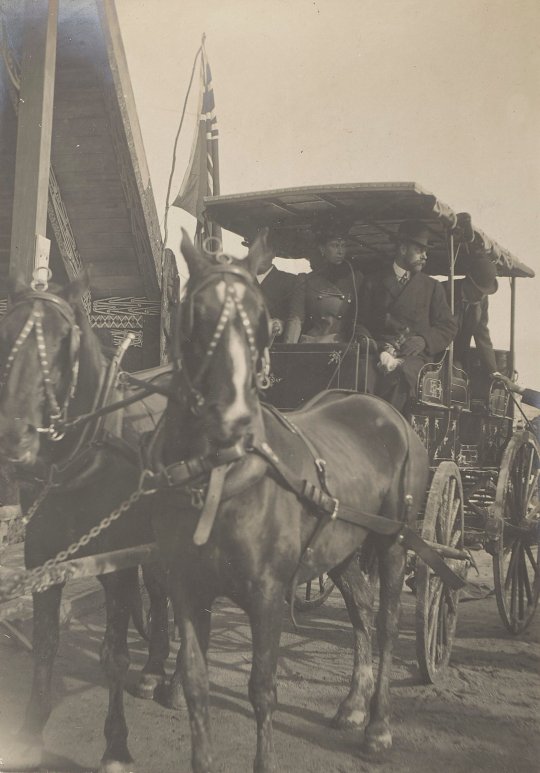

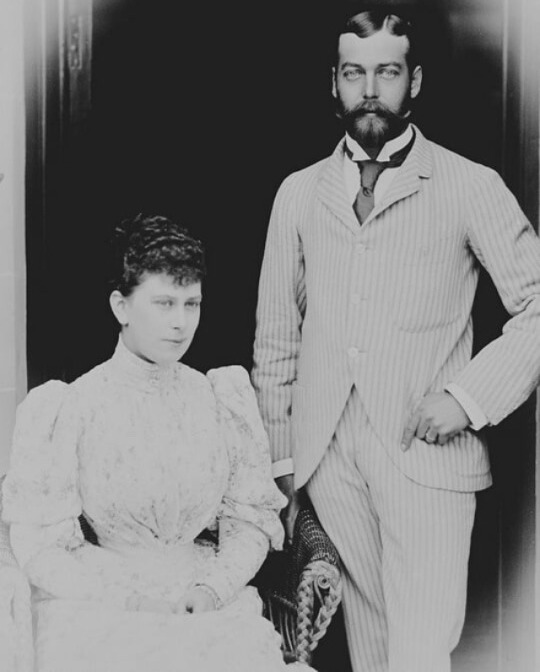

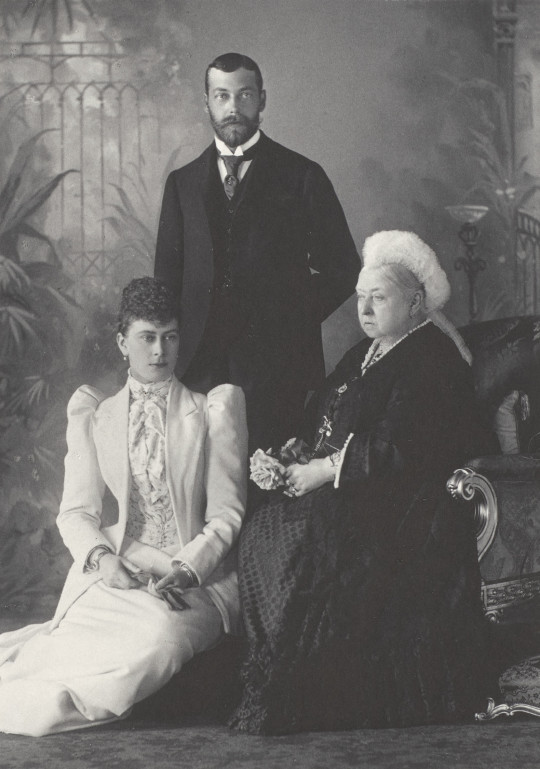
In 1893, on today's date (July 6th), George V married Mary of Teck. Their relationship started as an arranged marriage, but quickly bloomed into a deeply devoted and happy love match.
“I also want to tell you how happy how very happy I am with you now my own darling, at first I don’t think we were, but we did not understand each other properly, but I assure you I am indeed intensely happy & I hate you to be out of my sight; I love you my darling with all my heart & soul, I can’t say more than that.”
-George to May
"Meet me at the station – you can always get into the railway carriage & embrace me there instead of before the crowd!"
-May to George
“You will find me D.v. [Deo volente – God willing] waiting on the platform of the station, ready to kiss you, you mustn’t be shy. We will have a better kiss when we are alone in the house”
-George to May
“Very often I feel in despair, and if it wasn’t for you I should break down."
-George to May
All excerpts are from Never a Dull Moment by Jane Ridley
97 notes
·
View notes
Note
🔥 a character the fandom is loving wrong
Not to be all "I'm the best at Duck" about it, but frankly I am.
A thing I see a lot of people do with him is focus on his rigidity. That is, his unwavering devotion to the Great Western Way. And by extension, I think a lot people relate to this and project that Duck's comfort zone lies in strict adherence to schedules and routes and plans and all of those things being immutable and unchanging.
But the thing is, Duck's not actually rigid that way at all. A TTTE character who more aptly fits that description is Bruno, from the reboot series. (Which, I've only seen two episodes of thus far, but it gets the same kinda heat the CGI does so I am looking at haters askance the same way...)
Duck's quite willing to yield to new ideas and shift to new plans. Like, "School of Duck" is pretty much about this idea that Duck can be given one task and spend his time trying to accomplish it, only to switch to a better and more efficient plan when presented with one or when one occurs to him. A truly rigid character would never have thought of turning Dexter into a temporary schoolhouse because a truly rigid character wouldn't think outside and beyond the given perimeters of the task at hand.
And in "The Thomas Way", he acquiesces to Thomas heading up the train, even though Hatt's order was for Duck to, once he knows Thomas isn't bullshitting him again. It wasn't that Thomas wanted to deviate from the plan originally that Duck was so against; it's that the deviation was just Thomas wanting to fuck around while Harold was in disrepair. Once Thomas was leading the way with the purpose of avoiding bridges and tunnels, which is in line with the Great Western way of delivering Harold directly and promptly to the Search and Rescue, they probably ended up doing all kindsa incidental sightseeing.
The premise of "The Thomas Way" itself is that the day's plans have changed unexpectedly. Duck was surely supposed to be doing something else when he was asked to report to Callan Castle. He is not bothered a bit by this change in plans though; indeed, he's even reassuring Harold that everything will be set right shortly.
The reason Duck is so up and on about the Great Western Way is simply that his old railway worked out how shit should be done most efficiently and to do it any other way is just to waste of time reinventing wheels. In that regard, Duck's very flexible so long as the overarching Way is being observed.
Also, speaking of wasting time, I sometimes see Duck as being characterized chronically late for things and rushing about. I thiiink this comes from the line "Duck liked to bustle about", which does not mean he's harriedly scurrying about all the time, but that he likes to be busy and do his work at a lively 45 mph clip. I don't think Duck's ever rushed anywhere outside of "A Clean Shave". This is a guy who's got his shit on lock; he literally knows exactly when all his trains are leaving the station and how long they'll take to arrive and how much time in between jobs that he has to chill in the shed telling Henry about all the tenders he's accumulated (and how many tenders that is and also casually allotting time in his schedule to make sure they're shunted and coupled up for Henry when he arrives that evening to collect them).
Duck's never late for anything unless he runs himself into a puddle.
33 notes
·
View notes
Note
Would Nobby ever tell Thomas he saved him from the front lines? I doubt Thomas would remember some old engine in a glass box that literally told him to go sit in a factory for a week and then said he was going to “France” but I wonder if Nobby remembers Thomas? And when he gets big and basically becomes the face of steam locomotives, would Nobby ever reminisce and think “Damn. If I didn’t risk my tender for this kid I didn’t even know, would he still be here? Would Edward still be here? Would anyone know of the “No-Where” Railway and its engines?”
I’m not 100% sure but I think Thomas figured out at some point during/after the second war that Nobby had saved him from a very early death. He does remember that week or so in Barrow because he was so mad for so long after realising that Sodor is definitely not France and that he’d been “tricked”.
Nobby definitely remembers Thomas and on occasion, after a particularly annoying group of youngsters have blown through the museum (decked out, of course, in all the Thomas merch), has doubtless muttered “I should have let that tank engine board that bloody ship” just to relieve his feelings.
He doesn’t mean it of course, he’s well and proud of any life he’s helped save. I don’t think it’s ever occurred to him to take credit for the N.W.R.s prosperity even though you can indeed make a case for it. But FC1 was always ambitious with a terrific head for publicity, and he had become pretty devoted to his railway and engines long before Thomas became famous and, like. Sooo much has happened since that day in 1915. So yeah, you could make that case, but Nobby hasn’t connected that chain of causality and he might argue with you about it if you proposed it.
32 notes
·
View notes
Text
August recs
Okay, I've got a handful of miscellaneous recs, and then ten recs for Victoria Goddard's Nine Worlds series, which I'm putting under a cut because at least two of you I know are still reading and the recs are full of spoilers for At the Feet of the Sun. Enjoy!

MISC
The Long Way Home by itsnatalie (DCU, gen)
With Jason tentatively back in the Batfamily, things are going pretty well for him--except for the whole thing with Tim. But who gives a shit about Tim Drake?
But when Jason and Tim are pulled into a frightening race for their lives inside a labyrinth that's out to kill them, they may have to look past their differences just to stay alive. Maybe along the way, they'll discover they aren't as different as they thought, and family comes in many different forms.
Spectacular in every aspect: the horror, the action, the hurt/comfort, the brotherly devotion underlying their swarm of issues, and the ending. I really can't rec this one highly enough.
Late Night, North Station by raitala (Untamed, Wangxian)
Lan Zhan finds A-Yuan lost in the railway station. He maybe finds more than he bargained for. Some mornings you leave for the office and come back with a son (and possibly a husband too).
Sooooo sweet, with a lovely autistic LWJ POV. The sequel is still a WIP but is great so far.
Beginning at the End by WerewolvesAreReal (Temeraire, Granby/Little)
In many ways it seems that John's life revolves around William Laurence.
Lovely character study trilogy with Granby sorting out his unrequited thing for Laurence and his ongoing thing with Little.
thou, who art victory and law by The_Apocryphal_One (Goblin Emperor, Csethiro/Maia)
He couldn’t help his unintelligence, any more than she could help her father. And he was kind. She should try to remember that.
(Or: Csethiro Ceredin goes into her betrothal to Emperor Edrehasivar VII with assumptions, and has every one of them challenged.)
Great Csethiro POV as she works through her pride and preconceptions.
NINE WORLDS
Embers by alfgifu
Kip Mdang returns to Solaara, hardly confident that the Imperial Service will take him back but sure that there is no place for him in the Vangavaye-ve.
The City of Cities is still expanding from the backwater village it was before the Fall; the work of reconstruction continues but it is no longer a simple crisis. In the Palace the big political beasts are circling for position under the newly awakened Emperor.
Despondent and determined to bury himself in work, Cliopher finds his former patron disapproving and the new Master of Offices openly hostile. But he is still a fifth degree secretary, and some problems are easier to solve when you feel that you have little left to lose… and don't care which enemies you make along the way.
Amazing!!! Basically a novel-length series digging into the difficult period between Kip returning and Kip becoming the Hands of the Emperor, with tons of bureaucracy and corruption and competence porn and of course, his devotion to His Radiancy and building a better government. Also features wonderful OCs, worldbuilding, a really horrifying bit of magic, some unexpected allies, humor, and Kip being just a really lovely (and determined, and traumatized) person.
thank you!!! no walnuts!!! by mage-pie
Pikabe has fucked over his army career (and maybe his whole life) by refusing illegal orders to commit a war crime and kinda sorta leading a mutiny (he was cleared of wrongdoing, but still, mutiny). He’s been shuffled out of the way to some random base where everyone gives him the side-eye (because mutiny) and he’s never going to see anyone from his old unit ever again. (Which doesn’t matter, his former lieutenant’s also-fucked-over life is none of his business, whatever, it’s fine it’s fine.)
Then he gets a mysterious package and a mysterious Solaaran visitor who might have an idea about turning things around (a suggestion, even).
Fun possible backstory for Pikabe; part of a series that I haven't read in full yet but it stands alone.
Signals by Penguinity
Kiri cleared her throat, and the secretaries looked up as one. She waved the letters in one hand. “The stack in the second pigeonhole, what sort of letters are these?”
“The ones from people who aren’t crackpots, but don’t need help from our office.”
Cliopher nodded, satisfied. “Indeed, well-sorted.”
Kiri held up a finger to silence him. “And?”
There was a brief pause, before Gaudy gave an almost inaudible sigh and answered. “And who are flirting with Lord Mdang.”
SO funny, featuring the junior secretaries and Kip's ace obliviousness.
A Good Man by Quasar
It takes a while, but eventually Masseo discovers why a man with no name got saddled with a family curse.
Brilliant little premise run off that line about how Ludvic violating the Emperor's taboos would curse his whole family.
One Bed Too Many by white_hart
They slept beside each other on the deck of the vaha, and in a nest of cushions in the solarium, but this is the first time there's been a bed. In fact, there are two.
Sweet immediately-post-ATFOTS fic with them negotiating physical intimacy.
Five People Who Were Surprised The Next Time They Met Cliopher by Quasar
Five people who were astonished when they met Cliopher after the events of At The Feet Of The Sun.
What it says on the tin! A fun collection of people, culminating in Pali and Kip figuring out a detente.
Thrive in the Sun by electropeach
A day in the retired life of Cliopher Mdang: the sun, the sea, the wind, his fanoa… and a cousin baking up a storm in his kitchen. (Alternately titled "Enya Hears About Sardeet")
Immensely soft and funny series, with just a dash of feels about Fitzroy's tragic childhood.
The Tanà’s Day Off by rattyjol
Kip takes the day off. Fitzroy fills in.
In which they are so so cute and extremely married.
Homing by oliviacirce
Homing, adj., (1) having a natural ability to find the way home from a long distance away, (2) guiding or directing homeward; v., (1) to aim at something and move quickly and directly toward it
More on the theme of Kip and Fitzroy figuring out their asexual/allosexual relationship, with an assist from the retirement house squad. Lovely and domestic.
Kip Thistlethwaite by alfgifu
His tone was light on the offer itself, despite the sturdiness of his declaration of identity. She could refuse him with no embarrassment to either of them, turning this into a joke that they could laugh over with Basil later in the evening - but - but - those steady brown eyes were serious.
“A marriage of convenience?” she said, equally lightly, “how gallant, sirrah.”
I am going absolutely feral waiting for more of this delightful series, in which Kip happens to be visiting Basil when Jullanar is blackmailed, and offers himself as an alternative. The second story deals with the Emperor finding out that his secretary is indeed married to THAT Jullanar.
#nine worlds#the hands of the emperor#the untamed#wangxian#dcu#batman#batfam#goblin emperor#csethiro/maia#temeraire#granby/little#monthly recs#fic rec
30 notes
·
View notes
Text
The Leading Lady ~

Lady is the Goddess of steam engines, but of course, you already know this. She was the first to be hit by the infection when it started, and when she caught the illness, it began a chain reaction that resulted in every steam engine becoming sick as well. It was pretty catastrophic, and Burnett was trying every remedy that Mr Conductor or Junior could offer him.
Despite now being a monster engine, Lady isn't a monster at heart and is still the same kind-hearted and graceful engine that she was previously, minus the new predatory instincts. She and Thomas have a bit of a fling with each other and if anyone dares hurt him, they will feel her undying wrath.
She will pretty much eat anything that's given to her, but it's mostly fruit she favours rather than meat due to the blood-fest that was the "Incident". She feels utterly horrified and guilty for what happened and has been nearly inconsolable towards Burnett.
She often spends some time on her own at the Sodor, and sometimes lets Lily and Patch come with her. She also devotes some of her time to seeing Thomas and checking up on the other engines.
Fun fact; Lady's class doesn't exist on Earth, but in a huge pocket dimension, it does. She has tons of brothers and sisters that work on the Magic Railroad, which is actually called the "Aurum Ferrum Railway". A large majority of Mr Conductor's family work there :). There are also magic diesels :)
45 notes
·
View notes
Text
Anxiety I
by Tove Ditlevsen
Anxiety is old it
reeks of childhood it
has no object
is awakened by glances, words and
sudden noise
lives in recurring dreams where
the one you love
shows the deadly hatred he
hides by day.
People’s eyes are yellow they
are too close together and they
have no lashes
over them their
menacing eyebrows
run endlessly together
the corners of their mouths
dislocate and twist, watercolor-wet
do not look at them
slip away from any dangerous
and keen attention.
Wrap yourself in rhythms and
rhymes from the old
bygone songs
hide with the troll and
the dragon the
pure evil
shy away from all affection even
from the child who plays with and
caresses the cat
shy away from his expectation
his memories
his blocked future.
Seek the company of those who
peacefully turned away
want nothing from you
libraries waiting rooms
railway stations
people with suitcases
in hand have
firm contours
unknown
goals in a
world that is not yours.
All the others are transformed
under your stare as if
under windswept waves
they know that you see their
secrets and
innermost thoughts
hate your lurking and waiting
you do not know the day
of the catastrophe
approaching by the hour.
Anxiety is old your
father and your mother are
safety and danger
staring through your
lover’s eyes and are not dead.
Do not watch them. Lay
flowers on the grave light
candles at night
fold your hands and hum
in devotional horror the old
forgotten songs.
257 notes
·
View notes
Text
9th March 2024
Unacceptable behaviour by football fans, captured by one of my London Operational Team.
I will not mention the name of the south London football club... but, "Nobody likes us and we don't care" is one of their chants.
Why... WHY does soccer incite ordinary, decent working men to fight???
I can understand team loyalty and devotion... but, why the tribal mentality???
It is not as if the players come from the local vicinity anymore. 100 years ago I might have been able to understand a boisterous support of the local team... but not anymore!
It was crowd violence in the 1970's that put me off soccer... I was not very good at it anyway.
Back to today... Facial Recognition cameras were deployed at nearby railway stations. At least two men need to hide, if they do not want Police knocking on their door in the next few hours!
9 notes
·
View notes
Text
Conspiracy in practice
There's this thing I've talked about in the past, but it's kinda been a while. And it should NOT come as a surprise to anyone who knows me.
Some few years ago, I lived in San Francisco. I love the City by the Bay, and I love its history. Some of which is, as I'm sure anyone can predict, Really Fucked Up.
Like most cities, San Francisco has at times had trouble with the dead. Specifically, where to put them. They sort of have a tendency to build up, you see.
Now, when SF was originally established, there were (setting aside the existence of the Ohlone, who are important but not relevant to this specific topic) only two settlements: a crude sort of port on the harbor, roughly-ish where the Ferry Terminal is now; and the Mission somewhat further inland and still extant today.
The Mission of course maintained its own cemetery, but that was only for Catholics attached to the Mission. The rest of the population of the nascent community - who were, by and large, not particularly religious - had to find some other solution.
They opted to site a cemetery in a moderately convenient spot so far out of town that no one would ever have a problem with putting dead bodies there. Today we call that location "Civic Center".'
Rapidly realizing the short-sighted nature of that decision, they moved the municipal cemetery to a place even further from the rapidly-growing settlement. A place of bare dunes and cold wind coming off the Pacific; with no access to fresh water and no conceivable reason anyone would ever want to built there. A place fittingly called Lands End.
Now, Lands End was in fact a terrible place to build anything. And it might have remained an ignored terminus of the peninsula, had it not been for the cemetery.
Going to the cemetery was a challenging proposition at that time - into the 1880s, if memory serves. Except that a wealthy socialite and philanthropist, Alma Spreckels, built a railroad from the city out to the cemetery. These necropolis railways were not uncommon projects in the day: they sold two kinds of tickets, round-trip and one-way, for wildly different clientele. I do not think she could have predicted what that would do.
With a railway built to what was at the time rather cheap land, another wealthy person, one Adolph Sutro, saw an opportunity. He decided to develop the area, with an eye especially to the wealthy of the city. He built a bathhouse - well, by modern standards we'd call it more a waterpark - a luxurious seaside resort, and numerous other amenities. Lands End came to be seen not as an unpleasant place to put bodies, but rather as a location where the wealthy would go to play.
And yet, it was nonetheless also the location of the San Francisco Municipal Cemetery. In fact, it held several cemeteries: some few areas devoted to specific religious organizations, cemeteries for fraternal organizations, one for immigrants, and the aforementioned municipal interment.
Each one was different, of course. I could not give detail about the religious ones (except the Neptune Society, which is a unique exception here). The fraternal ones were interesting in their own right: a major draw to fraternal organizations such as the Oddfellows and the Freemasons was that they provided a sort of life insurance for members: they would bury said membership, and look after widows and underage children. So of course they maintained cemeteries for the former purpose. The immigrant cemetery was largely for Chinese laborers. And interestingly interment there was meant to be temporary, lasting only until the body was nothing but bones, which would then be shipped back to China to be buried in the homeland of the deceased - however, not everyone died with enough money for this, and in no few cases the surviving family was unable or unwilling to pay the costs.
Lastly, there was the Municipal Cemetery. This was a "potter's field" in which the city buried anyone whose body was not otherwise claimed. This was done cheaply, the plots were simply numbered, and often they did not even have a name - SF then as now did have a homeless population.
For a brief while, Lands End had a double life, being both a place of raucous merriment and one of somber mourning. The living, however, crowded out the dead. In the late 19th and early 20th centuries, many American cities decided they would not continue sharing space with the dead, and determined to move the latter entirely outside of municipal limits; thus freeing up city land for other - and more profitable - uses.
Thus it was with San Francisco, who wanted to expand use of the area, build a central park as was the fashion of the time, and become a truly modern city. And so began a somewhat grisly endeavor: exhuming the many bodies and transferring them to the new necropolis at Colma (still the largest necropolis in the USA; slogan: "It's great to be alive in Colma!").
The living next of kin found themselves on the hook for the costs of respectful treatment of their ancestors. Churches were obliged to handle the reburials when they had believed once was enough. Charitable organizations - where still in existence - were required to shoulder their reburial costs.
But that left the sprawling municipal cemetery. As with any city, they resolved to handle the matter cheaply. They doubtless reasoned that if there was no one alive who would pony up the money for a respectful exhumation and reburial, the dead had no one alive to object to digging up some bones and throwing them in a mass grave at a more convenient location. And they were correct.
In fact...
Well, do you know what would be cheaper than digging up bones and tossing them in a pit?
Not doing that. Simply removing the grave markers, assigning the numbered graves to burial pits, and not bothering with the expensive and unpleasant labor. So that's what they did. Or didn't do, depending on how you look at it. They pulled a poltergeist and merely removed the markers. When the city of San Francisco declared all bodies moved, and no additional burials allowed, many thousands of graves actually remained.
Subsequently, considerable construction occurred there. And this is where we get into something which is awful and yet to be expected. You see, this was not a secret. To a certain point of view, it can be understood that only a handful of people realized that when the exhumations and reburials were called done, they were not - after all, the only people who might have done the accounting and realized nothing of the sort had happened were those who had decided on such a course of inaction. To everyone else, the relocation of the poor and dead was Someone Else's Problem.
However, after that point, it must assuredly have been an open secret at least among workers. Simply put, you could not engage in the construction which happened there without regularly finding bones. And in the 90s when they performed extensive renovations to buildings in the area to make them Earthquake-resistant, they did indeed find extremely large numbers of unmarked graves, up to and well past the areas where they were authorized to dig. And even now, frequently some wealth household in the area will decide to add a garage or the like, and discover yet another grave.
This is where I might rail against the hypocrisy.
But right now I want to draw attention to another important point. The reality that the graves in Lands End were not properly moved was both well-known, and a secret, for most of a century. A great many people know it for a fact, but none of them chose to speak up.
There are times when people reasonably deride the idea that the US Government could conceal evidence of aliens, or whatever other vast and lofty conspiracy. And those arguments are valid.
And yet. We can see that it's perfectly possibly for hundreds - likely thousands - of people in a city to keep a secret. They did so by a combination of disinterest with the secret, and that revealing it would incur considerable personal loss for no hope of reward.
It is possibly to keep a secret... if no one gives a damn.
8 notes
·
View notes